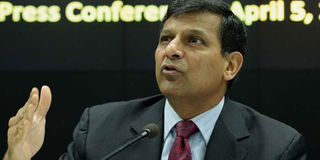India's central bank cuts key interest rate to five-year low

Reserve Bank of India (RBI) governor Raghuram Rajan speaks during a news conference at the RBI headquarters in Mumbai on April 5, 2016. India's central bank on April 5 cut its key interest rate to a five-year low of 6.5 percent citing a dip in inflation, and signalled there could be further rate cuts to come. / AFP PHOTO / PUNIT PARANJPE
What you need to know:
- India's consumer price inflation softened to a lower-than-expected 5.2 percent in February and has remained in line with the RBI's target in recent months.
- The summer monsoon rains, which have a critical impact on farmers' crops and thereby on the price of food, would be a key factor in deciding whether to ease the key interest rate further, she said.
- These two factors have given room for bank governor Rajan, whose main priority is to control once-runaway inflation, to loosen monetary policy by cutting interest rates.
India's central bank on Tuesday cut its key interest rate to a five-year low of 6.5 per cent citing a dip in inflation, and signalled there could be further rate cuts to come.
In a widely expected move, the Reserve Bank of India (RBI) said it would lower the benchmark repo rate, the level at which it lends to commercial banks, by 25 basis points down from 6.75 per cent.
The move, designed to lower the cost of borrowing and investing to provide a boost to consumers and the economy, takes the rate to its lowest level since early 2011.
"Retail inflation measured by the consumer price index (CPI) dropped sharply in February after rising for six consecutive months," RBI governor Raghuram Rajan said in the first policy statement of the new fiscal year.
The bank governor also said the RBI's stance on monetary policy would remain accommodative, suggesting the bank may make further cuts to interest rates this year.
"The Reserve Bank will continue to watch macro-economic and financial developments in the months ahead with a view to responding with further policy action as space opens up," Rajan said.
In a Bloomberg News survey of 42 economists, 36 had expected a cut of 25 basis points, while four had expected a deeper cut of 50 basis points and two foresaw no change.
"The overall tone has remained doveish, which also seems to suggest the RBI could be looking at further rate cuts," Shubhada Rao, chief economist at Yes Bank in Mumbai, told AFP.
The summer monsoon rains, which have a critical impact on farmers' crops and thereby on the price of food, would be a key factor in deciding whether to ease the key interest rate further, she said.
India's consumer price inflation softened to a lower-than-expected 5.2 percent in February and has remained in line with the RBI's target in recent months.
Finance Minister Arun Jaitley said in February the government would stick to an ambitious target to cut the fiscal deficit to 3.5 percent of gross domestic product in 2016-17.
GLOBAL HEADWINDS
These two factors have given room for bank governor Rajan, whose main priority is to control once-runaway inflation, to loosen monetary policy by cutting interest rates.
In the statement Tuesday, Rajan said CPI was expected to "decelerate modestly" to remain at around five percent in 2016-17.
"Amid signs of continued economic weakness, we had expected that the finance ministry's commitment to fiscal tightening in the 2016-17 budget, as well as the drop in inflation in February would pave the way for a cut in the repo rate," said Shilan Shah, India economist at Capital Economics.
The Indian government has said GDP likely grew 7.6 percent over the 2015-16 financial year, making it the world's fastest-growing major economy.
But Asia's third-largest economy faces severe headwinds from a shaky global economic climate that has dampened demand for Indian exports, while private investment remains weak.
In 2015 the RBI lopped 125 basis points off borrowing rates in four separate cuts. It last lowered rates on September 29 with a surprise 50-basis-point reduction.
But the Indian interest rate is still much higher than that of other major economies such as the United States or Japan, where benchmark rates are still hovering close to or below zero.
India's central bank kept interest rates on hold at its last policy meeting in February ahead of the government's annual budget.
AFP





